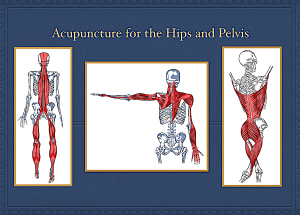Acupuncture for Musculoskeletal Pain: The Anatomy of Meridians, Myofascial Lines, and Biomechanics
UNITED STATES, December 28, 2021 /EINPresswire.com/ -- Acupuncture is an effective method for many musculoskeletal conditions including neck pain, shoulder tension, sciatica, hip pain, and more. High quality research studies continue to confirm the role of acupuncture in treating many kinds of disorders. Many of the therapeutic benefits of acupuncture can now be understood in structural and bio-mechanical terms.
For many disorders related to structural imbalances we can describe how muscles may be in either chronic contraction or strain. Muscles in chronic contraction become shortened, while those in chronic strain become lengthened. As muscles and muscle groups have antagonistic pairs, if one muscle group is in chronic contraction, the opposing muscle group will go into chronic strain. This can cause structural issues, poor alignment, and pain. Many conditions of the neck, shoulders, back, and hips result from imbalances between opposing muscle groups and misalignment.
Acupuncture for hip pain can be beneficial using both traditional methods and modern approaches that account for structural issues in the hip joint. For instance, external rotations in the hip and femur can cause lumbar, hip, groin, and knee pain. Traditionally, points like GB 30, GB 31, and GB 41 could be used for treating posterior-lateral hip pain. From a myofascial perspective these points will influence the gluteal muscles and IT band. However, with external rotation of the hip the deep lateral rotators will also be involved. To reach these deep rotators it requires using points like LV 3, KI 7, or even SP 9.
While traditional meridian theories speak of three leg yin meridians, the myofascial line model consolidates this into what is called the Deep Front Line (DFL). The DFL includes muscles like the toe flexors, tibialis posterior, the adductors, and psoas. By needling points like LV 3, KI 7, SP 9, and the Lower Three Emperors, it is possible to influence the deep muscles of the hips, pelvis, and lumbar spine. When chronic contraction exists within the deep lateral rotators of the hip joint, the leg yin acupuncture points may reduce myofascial imbalances in the DFL.
Similar biomechanical and structural analysis of the neck and shoulders, can also help us to understand how acupuncture points on the hands can treat neck and shoulder pain. In the image of the Superficial Back Arm Line (SBAL) we see that it includes the trapezius, deltoids, forearm extensors, and myofasciae on the dorsal part of the hand. Points like SJ 3, LI 4, Luo Zhen, and others located between the metacarpals are traditionally indicated for neck pain. Following principles of tensegrity and biomechanics we can begin to understand the beneficial effects of acupuncture for neck pain.
For researchers and clinicians in acupuncture it is essential to consider not only neurological mechanisms but also mechanical and structural effects.
James Spears
Integrative Healing Society
+1 415-367-3610
email us here
Acupuncture for Hip Pain
Legal Disclaimer:
EIN Presswire provides this news content "as is" without warranty of any kind. We do not accept any responsibility or liability for the accuracy, content, images, videos, licenses, completeness, legality, or reliability of the information contained in this article. If you have any complaints or copyright issues related to this article, kindly contact the author above.

